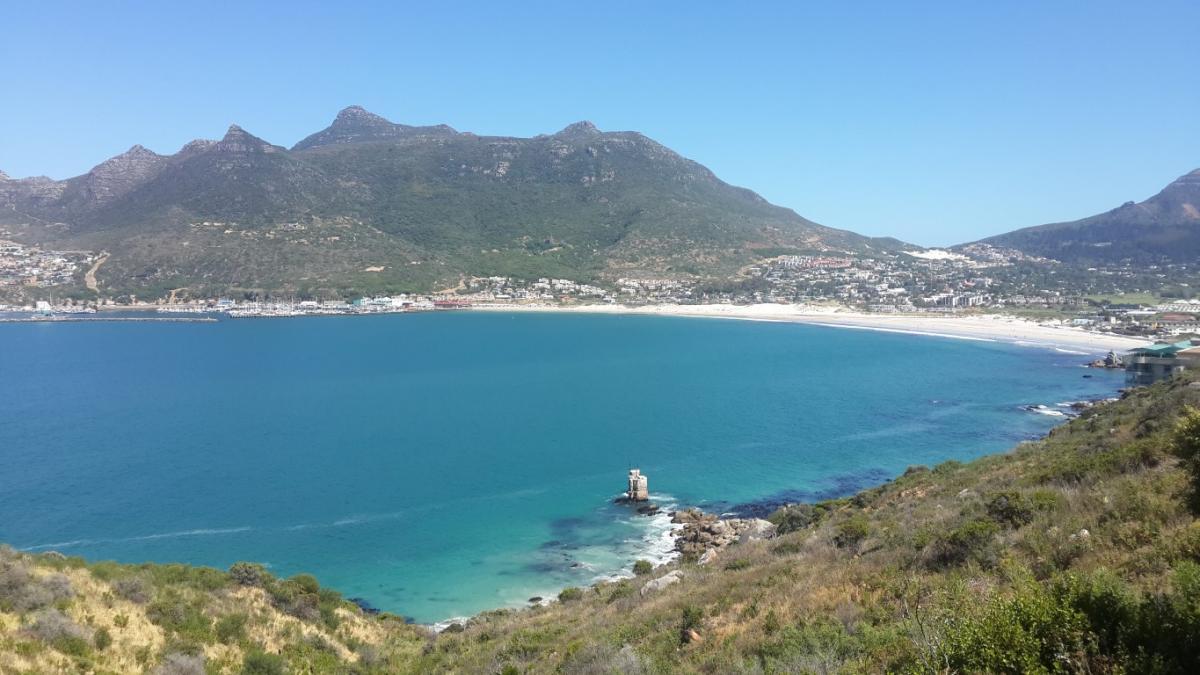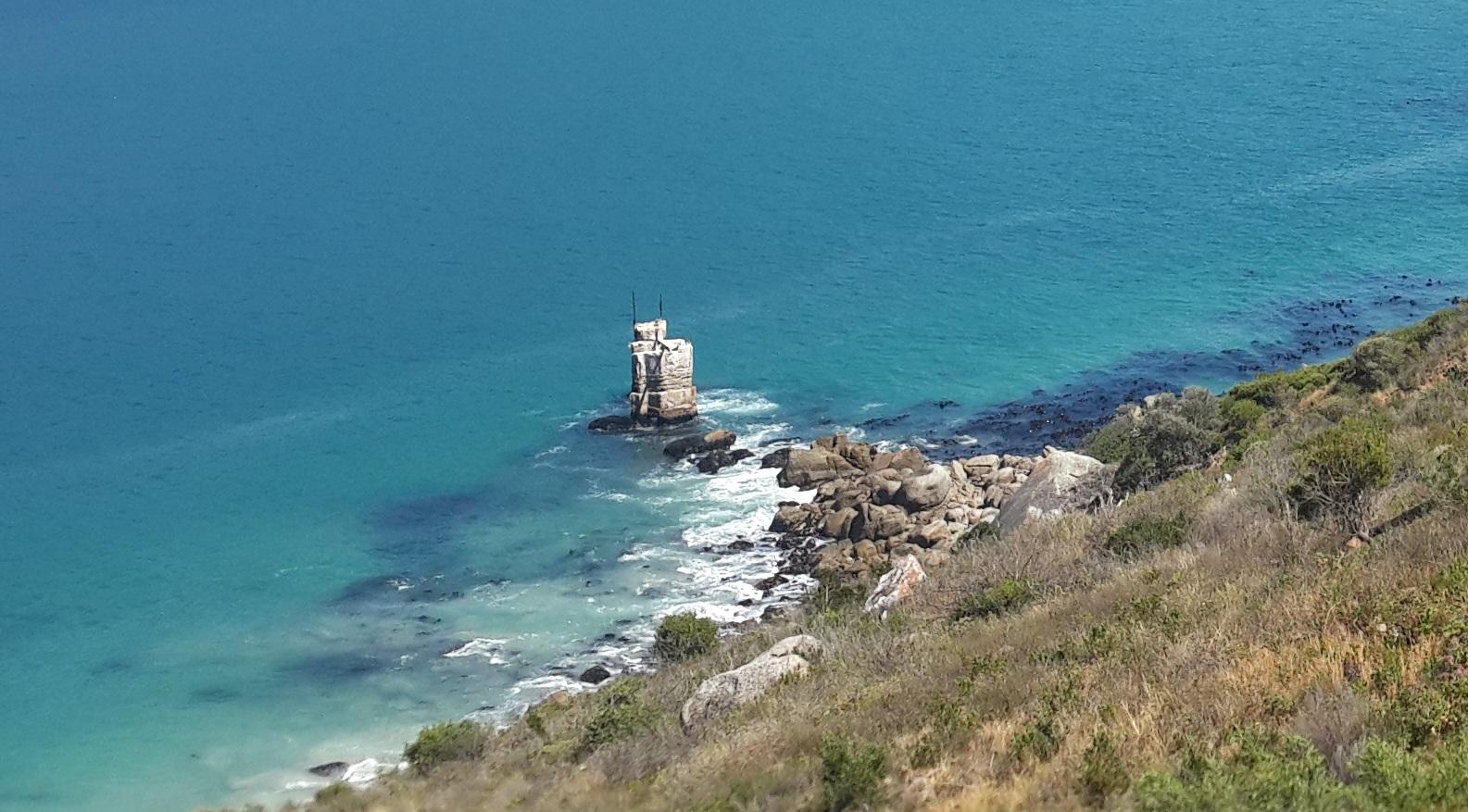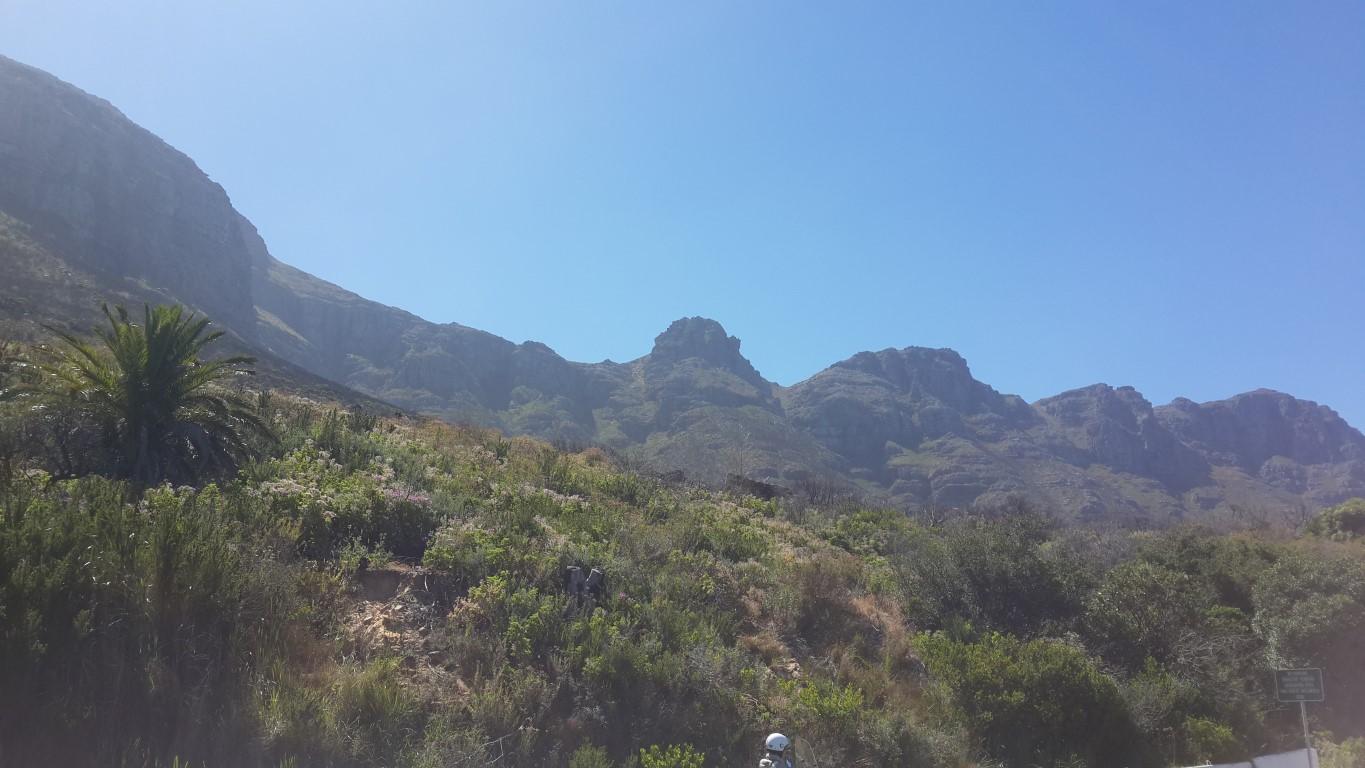
Disclaimer: Any views expressed by individuals and organisations are their own and do not in any way represent the views of The Heritage Portal. If you find any mistakes or historical inaccuracies, please contact the editor.
Few visitors driving through Hout Bay on the way to Chapman’s Peak Drive will have failed to notice in the sea below the road a curious concrete and steel jetty - usually the resting place of a number of cormorants drying themselves in the sun! This marks the most immediately visible remnant of one of the Cape’s most remarkable early mining ventures, the Hout Bay manganese mine.
The curious jetty (The Heritage Portal)
Although the dense forests surrounding Hout Bay – hence its name - had been noted by Jan Van Riebeeck and the settlement there had grown slowly but steadily it is astonishing that a further two centuries were to elapse until, in 1873, we find the first written account of the existence in the mountains above Hout Bay of the valuable metal manganese:
“On the 19th November [1873] I went to inspect another manganese mine in the vicinity of Hout Bay. Leaving our horses beyond the block-house in charge of a herd, we ascended the Noordhoek mountain by a very precipitous route, and after an hour’s stiff climb reached a rough track formed by a winter torrent, along which we stumbled over several specimens of the ore; these had been washed down no great distance. Guided by Capt. E., I came to the most promising spot which he had discovered. There were certainly some very good specimens of manganese; but much of it was largely associated with sandstone, and unless surface blasting reveals a considerably larger supply than is promised on the surface, the cost of extracting the ore will be considerable. It certainly has the advantage of being less than two miles from a port; but otherwise it will bear no comparison with the mine in Du Toit’s Kloof. It is probable that a large quantity of manganese will be found in the vicinity of Hout Bay and Noordhoek; but whether it will pay to extract the ore and send it home is at present problematical.”
It was not long before news of the deposit entered the public domain for the following year a sample of ore from the Hout Bay deposit was displayed in the city - although a few months later it was pronounced as being of ‘a very inferior character’!
A number of accounts of the Hout Bay manganese deposits state that in 1880 a company was formed in Cape Town to exploit the Hout Bay manganese deposits, but no firm evidence of this venture has thus far come to light.
However, in 1882 Robert (later Sir Robert) Hadfield, an eminent British metallurgist, made a remarkable discovery. Steel was tough but not very hard while cast iron was hard but brittle. Hadfield was therefore searching for a material which possessed the toughness of steel with the hardness of cast iron. Eventually he discovered that an iron-manganese alloy possessed just those qualities - as well as being remarkably resistant to abrasion. This discovery was to change the face of metallurgy throughout the world - and perhaps even the very nature of Western society itself - and make manganese one of the most important of all alloying elements, a quality which it retains to this day in numerous extremely important products such as railway tracks. It also meant that manganese deposits now assumed greater importance and were eagerly sought throughout the world.
Given the importance of manganese as an alloying element it is surprising that it was only in 1893 that the ore from the Hout Bay deposit was assayed, apparently for the first time. This was carried out by Mr. P. Lee of the South African College laboratory who found that it contained between 76% and 83% of manganese dioxide.
Silence then descended upon the Hout Bay deposits until in 1905 a Mr A K Morrison applied for permission to prospect in the Forest Reserve at Hout Bay. There is no record as to whether his application for a prospector’s licence was successful, or what he discovered, but it is significant that on 5th of September that year the Cape Manganese Ore Company Ltd., was registered in London, one of its purpose being ‘to acquire from E. T. Boxall, H. Van den Bergh, and H. S. McKinnon mining rights over an area of 46 morgen in the Hout Bay Forest Reserve, Constantia, Cape Colony.’ The purchase consideration was £61,060, payable £1,060 cash and £60,000 in full-paid shares.
The year 1909 marked a turning point in the history of mining in Hout Bay for in June that year the Memorandum and Articles of Association of ‘Hout Bay Manganese Ltd.’ were registered in Cape Town, with the first Annual General meeting of the company being held in Cape Town on the 9th of July.
However, development work on the mine must have been proceeding well before the registration of the company for in March of that same year the important London weekly publication South Africa (“A Weekly Journal for all Interested in South African Affairs”) reported in an anonymous article headed ‘The Cape’s Metalliferous Wealth’ that
“… manganese, which is common in the mountains of the Cape Peninsula, had until recently failed to prove a payable proposition, the cost of labour and difficulty of haulage being obstacles to enterprise in this respect. At Hout Bay, however, the difficulty has been solved, and a manganese mine is actually at work. Manganese ore is being shipped from the Cape to Belgium, where it has been favourably reported on. As regards the manganese mine at Hout Bay, a shute, erected on poles, extends from top to bottom of the mountain, a distance of some 2000 to 2500 feet. [600 to 750 m] Down the shute, at an angle of something like 45 degrees, the manganese ore comes tumbling to the sea shore. At the mountain base a jetty is being built, so that lighters may come alongside, fill up, and discharge their cargo into the ships waiting in the Bay. Some weeks ago a dozen or so White men were already busily drilling the summit of the mountain, while manganese ore stood stacked in patches near, like stacks of coal on a wharf awaiting shipment”
The mountains above Chapmans Peak Drive (The Heritage Portal)
The shute was by any standards a most extraordinary structure. As described above it was constructed of wooden poles – 16 000 in number according to one account – and dropped in a sharp decline several hundred metres from the mine to the edge of the sea. Presumably in order to reduce the speed of the pieces of ore sliding down the steeply inclined shute it curved away and then back towards the jetty. The shute was lined by corrugated iron sheets and apart from being open at the top for ore to be loaded there was at least one what one may call a loading station someway down the shute.
The shute ended a short distance from the edge of the sea, where a stone and concrete jetty was constructed using material purchased from the engineering firm of Sir John Jackson Ltd. in Simonstown. From the bottom of the shute a short cocopan line transported the ore on to and along to the end of the jetty, where the ore was tipped into flat-bottomed lighters. These then conveyed the ore to a ship anchored in deep water not far from the shore. The ore was not processed further at the Cape but shipped to Europe where it would have been used either in the production of chlorine or as an alloying element with iron.
As the manganese ore occurred in a relatively narrow vein running vertically up the side of the mountain a set of eight adits (i.e. horizontal tunnels) were driven into the side of the hill. These varied from about 20 to 85 metres in length and up to a few metres in width. After being stacked outside the lowest of the adits the ore was sorted by eye and by hand, according to the amount of manganese it contained: the higher the purity the blacker and denser it was, while the lower grade ore was both lower in density and browner in colour as a result of the iron oxide impurity it contained. After sorting the ore was stacked in heaps a metre or so high awaiting transport to the head of the shute and several substantial piles of this hand-sorted ore – totalling at least several hundred tons in weight – still lie at grass to the north and somewhat below the lowest of the adits. The piles are supported by drystone retaining walls, still in excellent condition.
It should be mentioned that there is an apocryphal story that the shute ended on the jetty itself and that on one occasion the ore emerging at high speed from the bottom of the shute went right through the bottom of the waiting lighter, sinking it. Indeed, the remains of the lighter are said to still be visible on the sea floor!
There is no doubt that the mine exported manganese ore in the year 1910. Yet by 1912 - even though that substantial quantity of ore was still lying in heaps up on the hillside – the mine had closed. The reasons for this are still not completely clear, although it is known that the company had experienced much trouble with the shute. Perhaps the answer is simply that the company had, like so many mines before and since, ran out of capital, or perhaps the ore, which had been found to contain an undesirable high proportion of phosphorus, was now found to be unsuitable in the production of alloy.
In 1929 an attempt was made to reopen the mine, with the local press reporting that ‘Capital is being raised to work the manganese on the slopes of the Hout bay mountains …’ However, Given that the giant manganese deposits at Postmasburg in the Northern Cape had been discovered some three years before in 1926 it defies logic that anybody should attempt to resume working a tiny deposit such as that at Hout Bay. What can be said, however, is that this historically unique mine is most worthy of our systematic protection and restoration.
[Originally published in 2013]
Comments will load below. If for any reason none appear click here for some troubleshooting tips. If you would like to post a comment and need instructions click here.


